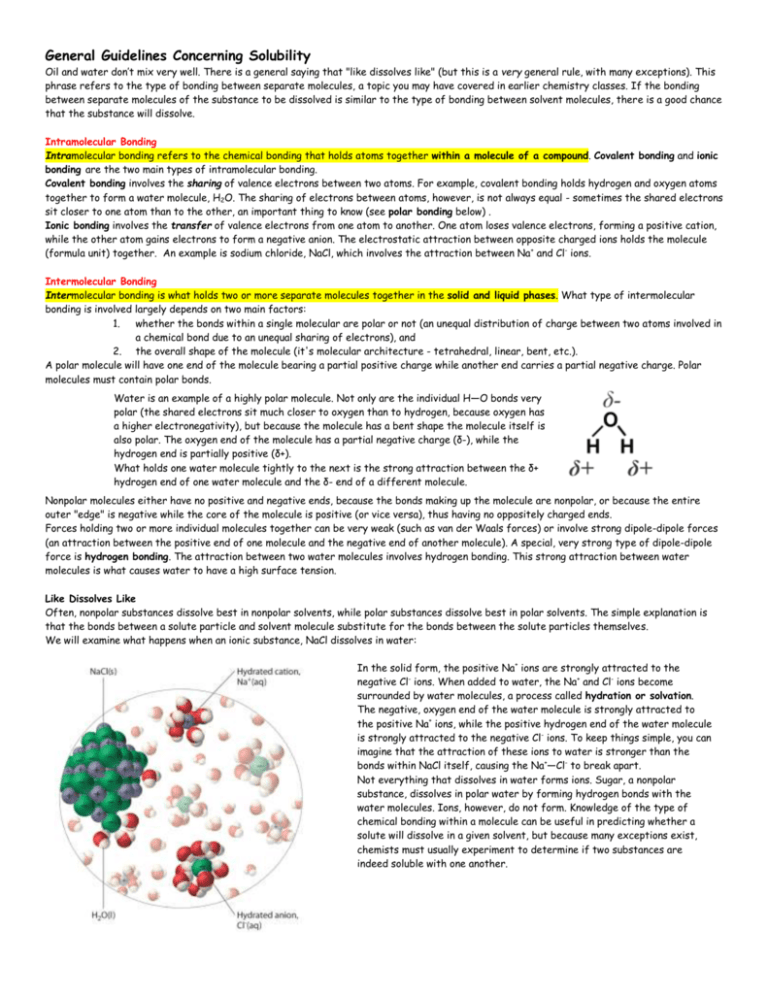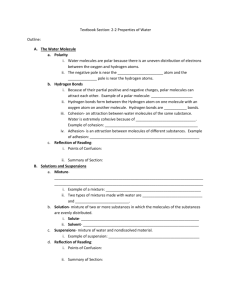Intermolecular Forces
advertisement

General Guidelines Concerning Solubility Oil and water don’t mix very well. There is a general saying that "like dissolves like" (but this is a very general rule, with many exceptions). This phrase refers to the type of bonding between separate molecules, a topic you may have covered in earlier chemistry classes. If the bonding between separate molecules of the substance to be dissolved is similar to the type of bonding between solvent molecules, there is a good chance that the substance will dissolve. Intramolecular Bonding Intramolecular bonding refers to the chemical bonding that holds atoms together within a molecule of a compound. Covalent bonding and ionic bonding are the two main types of intramolecular bonding. Covalent bonding involves the sharing of valence electrons between two atoms. For example, covalent bonding holds hydrogen and oxygen atoms together to form a water molecule, H2O. The sharing of electrons between atoms, however, is not always equal - sometimes the shared electrons sit closer to one atom than to the other, an important thing to know (see polar bonding below) . Ionic bonding involves the transfer of valence electrons from one atom to another. One atom loses valence electrons, forming a positive cation, while the other atom gains electrons to form a negative anion. The electrostatic attraction between opposite charged ions holds the molecule (formula unit) together. An example is sodium chloride, NaCl, which involves the attraction between Na+ and Cl- ions. Intermolecular Bonding Intermolecular bonding is what holds two or more separate molecules together in the solid and liquid phases. What type of intermolecular bonding is involved largely depends on two main factors: 1. whether the bonds within a single molecular are polar or not (an unequal distribution of charge between two atoms involved in a chemical bond due to an unequal sharing of electrons), and 2. the overall shape of the molecule (it's molecular architecture - tetrahedral, linear, bent, etc.). A polar molecule will have one end of the molecule bearing a partial positive charge while another end carries a partial negative charge. Polar molecules must contain polar bonds. Water is an example of a highly polar molecule. Not only are the individual H—O bonds very polar (the shared electrons sit much closer to oxygen than to hydrogen, because oxygen has a higher electronegativity), but because the molecule has a bent shape the molecule itself is also polar. The oxygen end of the molecule has a partial negative charge (δ-), while the hydrogen end is partially positive (δ+). What holds one water molecule tightly to the next is the strong attraction between the δ+ hydrogen end of one water molecule and the δ- end of a different molecule. Nonpolar molecules either have no positive and negative ends, because the bonds making up the molecule are nonpolar, or because the entire outer "edge" is negative while the core of the molecule is positive (or vice versa), thus having no oppositely charged ends. Forces holding two or more individual molecules together can be very weak (such as van der Waals forces) or involve strong dipole-dipole forces (an attraction between the positive end of one molecule and the negative end of another molecule). A special, very strong type of dipole-dipole force is hydrogen bonding. The attraction between two water molecules involves hydrogen bonding. This strong attraction between water molecules is what causes water to have a high surface tension. Like Dissolves Like Often, nonpolar substances dissolve best in nonpolar solvents, while polar substances dissolve best in polar solvents. The simple explanation is that the bonds between a solute particle and solvent molecule substitute for the bonds between the solute particles themselves. We will examine what happens when an ionic substance, NaCl dissolves in water: In the solid form, the positive Na+ ions are strongly attracted to the negative Cl- ions. When added to water, the Na+ and Cl- ions become surrounded by water molecules, a process called hydration or solvation. The negative, oxygen end of the water molecule is strongly attracted to the positive Na+ ions, while the positive hydrogen end of the water molecule is strongly attracted to the negative Cl- ions. To keep things simple, you can imagine that the attraction of these ions to water is stronger than the bonds within NaCl itself, causing the Na+—Cl- to break apart. Not everything that dissolves in water forms ions. Sugar, a nonpolar substance, dissolves in polar water by forming hydrogen bonds with the water molecules. Ions, however, do not form. Knowledge of the type of chemical bonding within a molecule can be useful in predicting whether a solute will dissolve in a given solvent, but because many exceptions exist, chemists must usually experiment to determine if two substances are indeed soluble with one another. Extra Notes INTERMOLECULAR FORCES IN COVALENT COMPOUNDS Intermolecular bonding is what holds two or more separate molecules together in the solid and liquid phases There are three types of intermolecular forces that exist in covalent compounds: 1. Dipole - dipole forces These forces are present in polar molecules. The partially positive end of one molecule is attracted to the partially negative end of another molecule. The below diagram shows the dipole-dipole interaction between five molecules 2. London Dispersion Forces (also called London forces or dispersion forces or induced dipole) - These forces are present in nonpolar substances. The magnitude of London dispersion forces depends on the polarizability of the molecule and the shape of the molecule. Polarizability refers to the ease of distortion of the electron cloud associated with an atom or molecule. Polarizability generally increases with increasing number of electrons and larger size of the atom or molecule With regard to shape, molecules with shapes that result in more molecular surface area give rise to higher dispersion forces than shapes with less surface area. Therefore, linear molecules have larger London dispersion forces than spherical molecules. Note that all molecules have London dispersion forces because all molecules contain electron clouds. Picture 1 The average electron clouds of two nonpolar molecules. Picture 2 At any instant the electron distribution around an atom or molecule will likely produce a dipole which will average out to zero over a period of time. Picture 3 But even a temporary dipole can induce a temporary dipole in any nearby molecules causing them to be attracted to the first molecule. It is the polarizability of the molecules which determines the size of the temporary and induced dipole moments and thus the strength of the dispersion forces. 3. Hydrogen Bonding - a special type of very strong dipole-dipole interaction, present in compounds that contain an O-H, N-H, or H-F bond. No compounds can exhibit hydrogen bonding without one of these three bonds. The below diagram shows the hydrogen bonding (dashed lines) between water molecules. The hydrogen bonds that form between water molecules account for some of the unique properties of water. The attraction created by hydrogen bonds keeps water liquid over a wider range of temperature than is found for any other molecule its size. The energy required to break multiple hydrogen bonds causes water to have a high boiling point (a large amount of energy is needed to convert liquid water, where the molecules are attracted through their hydrogen bonds, to water vapor, where they are not) As a result of hydrogen bonding between water molecules: The evaporation of sweat, used by many mammals to cool themselves, achieves this by the large amount of heat needed to break the hydrogen bonds between water molecules. Moderating temperature shifts in the ecosystem (which is why the climate is more moderate near large bodies of water like the ocean)









